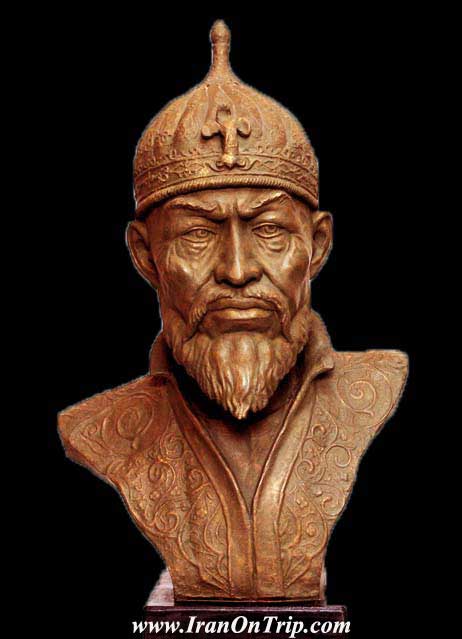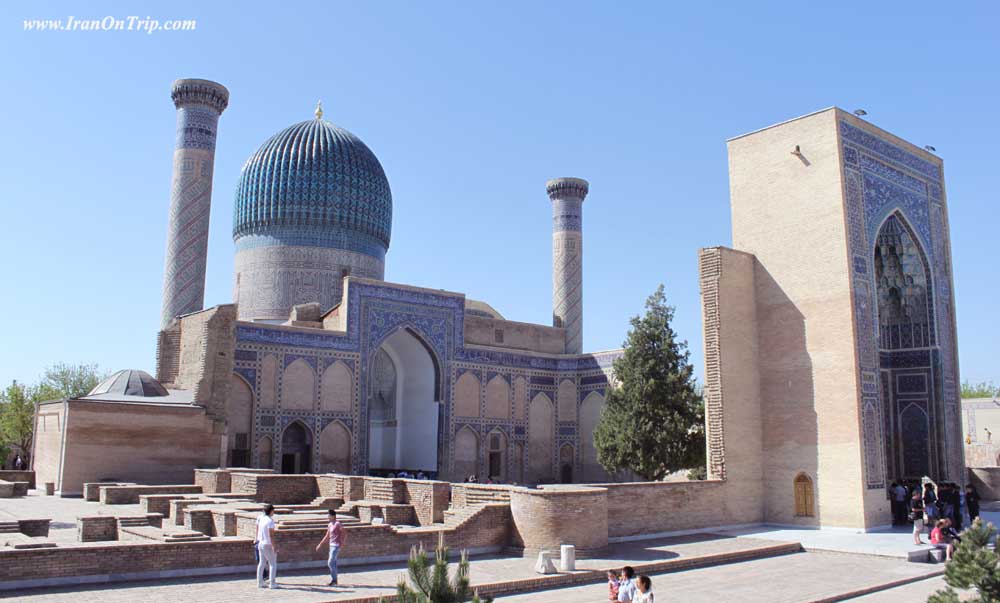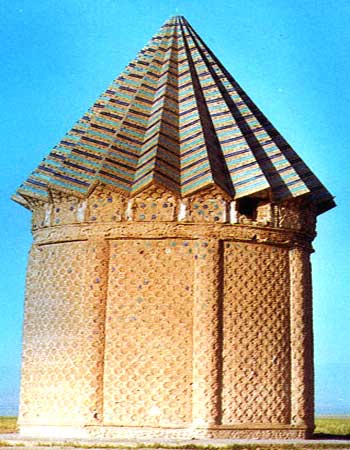Timurid dynasty

The Timurid dynasty (Persian: تیموریان), self-designated GurkAnI (Persian: گوركانى), was a Persianate, Sunni Muslim dynasty of Turco-Mongol lineage which ruled over modern-day Iran, Afghanistan, much of Central Asia, as well as parts of contemporary Pakistan, India, Mesopotamia, Anatolia and the Caucasus. The dynasty was founded by Timur (Tamerlane) in the 14th century.
The Timurids lost control of most of Persia to the Safavid dynasty in 1501, but members of the dynasty continued to rule parts of Central Asia and parts of India, sometimes known as the Timurid Emirates. In the 16th century, Babur, a Timurid prince from Ferghana (modern Uzbekistan), invaded Kabulistan (modern Afghanistan) and established a small kingdom there, and from there 20 years later he invaded Hindustan to establish the Mughal Empire
Origins

The origin of the Timurid dynasty goes back to the Mongol tribe known as Barlas, who were remnants of the original Mongol army of Genghis Khan. After the Mongol conquest of Central Asia, the Barlas settled in what is today southern Kazakhstan, from Shymkent to Taraz and Almaty, which then came to be known for a time as Moghulistan – "Land of Mongols" in Persian – and intermingled to a considerable degree with the local Turkic and Turkic-speaking population, so that at the time of Timur's reign the Barlas had become thoroughly Turkicized in terms of language and habits.
Additionally, by adopting Islam, the Central Asian Turks and Mongols adopted the Persian literary and high culture which had dominated Central Asia since the early days of Islamic influence. Persian literature was instrumental in the assimilation of the Timurid elite to the Perso-Islamic courtly culture.
History
Timur conquered large parts of Central Asia, primarily Transoxiana and Khorasan, from 1363 onwards with various alliances (Samarkand in 1366, and Balkh in 1369), and was recognized as ruler over them in 1370. Acting officially in the name of Suurgatmish, the Chagatai khan, he subjugated Transoxania and Khwarazm in the years that followed. Already in the 1360s had he gained control of the western Chagatai Khanate and while as emir he was nominally subordinate to the khan, in reality it was now Timur that picked the khans who became mere puppet rulers. The western Chagatai khans were continually dominated by Timurid princes in the 15th and 16th centuries and their figurehead importance was eventually reduced into total insignificance.
Rise
Timur began a campaign westwards in 1380, invading the various successor states of the Ilkhanate. By 1389, he had removed the Kartids from Herat and advanced into mainland Persia where he enjoyed many successes. This included the capture of Isfahan in 1387, the removal of the Muzaffarids from Shiraz in 1393, and the expulsion of the Jalayirids from Baghdad. In 1394–95, he triumphed over the Golden Horde, following his successful campaign in Georgia, after which he enforced his sovereignty in the Caucasus. Tokhtamysh, the khan of the Golden Horde, was a major rival to Timur in the region. He also subjugated Multan and Dipalpur in modern day Pakistan in 1398, and in modern day India left Delhi in such ruin that it is said for two months "not a bird moved wing in the city". Timur gave the north Indian territories to a non-family member, Khizr Khan, whose Sayyid dynasty replaced the defeated Tughlaq dynasty of the Sultanate of Dehli. Delhi became a vassal of the Timurids but obtained independence in the years following the death of Timur.
In 1400–1401 he conquered Aleppo, Damascus and eastern Anatolia, in 1401 he destroyed Baghdad and in 1402 defeated the Turks in the Battle of Ankara. This made Timur the most preeminent Muslim ruler of the time, as the Ottoman Empire plunged into civil war. Meanwhile he transformed Samarkand into a major capital and seat of his realm.
Timur appointed his sons and grandsons to the main governorships of the different parts of his empire, and outsiders to some others. After his death in 1405, the family quickly fell into disputes and civil wars, and many of the governorships became effectively independent. However, Timurid rulers continued to dominate Persia, Afghanistan, Pakistan, India and much of Central Asia, though the Anatolian and Caucasian territories were lost by the 1430s. Due to the fact that the Persian cities were desolated by wars, the seat of Persian culture was now in Samarkand and Herat, cities that became the center of the Timurid renaissance. The cost of Timur's conquests amount to the deaths of possibly 17 million people, and the loss to culture from the destruction of libraries and historic sites is incalculable.
Fall

By 1500, the divided and wartorn Timurid Empire had lost control of most of its territory and within the following years were effectively pushed back on all fronts. Persia fell quickly to the Shiite Safavid dynasty, secured by Shah Ismail I in the following decade. Much of the Central Asian lands was overrun by the Uzbeks of Muhammad Shaybani who conquered the key cities of Samarkand and Herat in 1505 and 1507, and founded the Khanate of Bukhara. From Kabul, the Mughal Empire was established by Babur, a descendant of Timur through his father and possibly a descendant of Genghis Khan through his mother, in 1526. The dynasty he established is commonly known as the Mughal dynasty though it was directly inherited from the Timurids. By the 17th century, the Mughal Empire ruled most of India, but eventually declined during the following century. The Timurid dynasty finally came to an end as the remaining nominal rule of the Mughals was abolished by the British Empire following the 1857 rebellion.
Culture

Goharshad mosque.Abbasid Ivan in Atiq yard Imam Reza complex Mashad. Iran.
Although the Timurids hailed from the Barlas tribe which was of Turkicized Mongol origin, they had embraced Persian culture, converted to Islam and resided in Turkestan and Khorasan. Thus, the Timurid era had a dual character, which reflected both the Turco-Mongol origins and the Persian literary, artistic, and courtly high culture of the dynasty
Language
During the Timurid era, Central Asian society was bifurcated and had divided the responsibilities of government and rule into military and civilian along ethnic lines. At least in the early stages, the military was almost exclusively Turko-Mongolian, and the civilian and administrative element was almost exclusively Persian. The spoken language shared by all the Turko-Mongolians throughout the area was Chaghatay. The political organization hearkened back to the steppe-nomadic system of patronage introduced by Genghis Khan. The major language of the period, however, was Persian, the native language of the Tājīk (Persian) component of society and the language of learning acquired by all literate and/or urban people. Already Timur was steeped in Persian culture and in most of the territories which he incorporated, Persian was the primary language of administration and literary culture. Thus the language of the settled "diwan" was Persian, and its scribes had to be thoroughly adept in Persian culture, whatever their ethnic origin. Persian became the official state language of the Timurid Empire and served as the language of administration, history, belles lettres, and poetry. The Chaghatay language was the native and "home language" of the Timurid family while Arabic served as the language par excellence of science, philosophy, theology and the religious sciences.
Literature
Persian

Persian literature, especially Persian poetry occupied a central place in the process of assimilation of the Timurid elite to the Perso-Islamic courtly culture. The Timurid sultans, especially Šāhrukh Mīrzā and his son Mohammad Taragai Oloğ Beg, patronized Persian culture. Among the most important literary works of the Timurid era is the Persian biography of Timur, known as "Zafarnāmeh" (Persian: ظفرنامه), written by Sharaf ud-Dīn Alī Yazdī, which itself is based on an older "Zafarnāmeh" by Nizām al-Dīn Shāmī, the official biographer of Timur during his lifetime. The most famous poet of the Timurid era was Nūr ud-Dīn Jāmī, the last great medieval Sufi mystic of Persia and one of the greatest in Persian poetry. In addition, some of the astronomical works of the Timurid sultan Ulugh Beg were written in Persian, although the bulk of it was published in Arabic. The Timurid ruler Baysunğur also commissioned a new edition of the Persian national epic Shāhnāmeh, known as Shāhnāmeh of Baysunğur, and wrote an introduction to it. According to T. Lenz:
“ It can be viewed as a specific reaction in the wake of Timur's death in 807/1405 to the new cultural demands facing Shahhrokh and his sons, a Turkic military elite no longer deriving their power and influence solely from a charismatic steppe leader with a carefully cultivated linkage to Mongol aristocracy. Now centered in Khorasan, the ruling house regarded the increased assimilation and patronage of Persian culture as an integral component of efforts to secure the legitimacy and authority of the dynasty within the context of the Islamic Iranian monarchical tradition, and the Baysanghur Shahnameh, as much a precious object as it is a manuscript to be read, powerfully symbolizes the Timurid conception of their own place in that tradition. A valuable documentary source for Timurid decorative arts that have all but disappeared for the period, the manuscript still awaits a comprehensive monographic study.
Chagatay
The Timurids also played a very important role in the history of Turkic literature. Based on the established Persian literary tradition, a national Turkic literature was developed in the Chagatay language. Chagatay poets such as Mīr Alī Sher Nawā'ī, Sultan Husayn Bāyqarā, and Zāher ud-Dīn Bābur encouraged other Turkic-speaking poets to write in their own vernacular in addition to Arabic and Persian. The Bāburnāma, the autobiography of Bābur (although being highly Persianized in its sentence structure, morphology, and vocabulary), as well as Mīr Alī Sher Nawā'ī's Chagatay poetry are among the best-known Turkic literary works and have influenced many others.
Art
During the reign of the Timurids, the golden age of Persian painting was ushered. During this period — and analogous to the developments in Safavid Persia — Chinese art and artists had a significant influence on Persian art. Timurid artists refined the Persian art of the book, which combines paper, calligraphy, illumination, illustration and binding in a brilliant and colourful whole. It was the Mongol ethnicity of the Chaghatayid and Timurid Khans that is the source of the stylistic depiction Persian art during the Middle Ages. These same Mongols intermarried with the Persians and Turks of Central Asia, even adopting their religion and languages. Yet their simple control of the world at that time, particularly in the 13–15th centuries, reflected itself in the idealised appearance of Persians as Mongols. Though the ethnic make-up gradually blended into the Iranian and Mesopotamian local populations, the Mongol stylism continued well after, and crossed into Asia Minor and even North Africa.
Timurid architecture

Akhangan tomb 14th-century Razavi Khorasan province
In the realm of architecture, the Timurids drew on and developed many Seljuq traditions. Turquoise and blue tiles forming intricate linear and geometric patterns decorated the facades of buildings. Sometimes the interior was decorated similarly, with painting and stucco relief further enriching the effect. Timurid architecture is the pinnacle of Islamic art in Central Asia. Spectacular and stately edifices erected by Timur and his successors in Samarkand and Herat helped to disseminate the influence of the Ilkhanid school of art in India, thus giving rise to the celebrated Mughal (or Mongol) school of architecture. Timurid architecture started with the sanctuary of Ahmed Yasawi in present-day Kazakhstan and culminated in Timur's mausoleum Gur-e Amir in Samarkand.
Timur's Gur-I Mir, the 14th-century mausoleum of the conqueror is covered with ‘’turquoise Persian tiles’’ Nearby, in the center of the ancient town, a Persian style Madrassa (religious school) and a Persian style Mosque by Ulugh Beg is observed. The mausoleum of Timurid princes, with their turquoise and blue-tiled domes remain among the most refined and exquisite Persian architecture. Axial symmetry is a characteristic of all major Timurid structures, notably the Shāh-e Zenda in Samarkand, the Musallah complex in Herat, and the mosque of Gowhar Shād in Mashhad. Double domes of various shapes abound, and the outsides are perfused with brilliant colors. Timur's dominance of the region strengthened the influence of his capital and Persian architecture upon India
.....
.....
.....

.jpg)



























